
Back to Basics: October 2012
Mark Van
Features Fire Ground TrainingA mayday firefighter may be pinned by heavy debris or objects that have collapsed onto him or her during interior or exterior operations.
A mayday firefighter may be pinned by heavy debris or objects that have collapsed onto him or her during interior or exterior operations. There are videos on the Internet showing a building collapsing partially on top of firefighters, trapping them beneath the burning rubble. This can happen easily while conducting fire-ground operations on the inside or the outside. For outside operations, it is imperative that collapse zones (one-and-a-half times the height of the building) be established to avoid the potential for entrapment by building material. When a firefighter is trapped underneath heavy debris or objects, there is no way that human muscle will be able to safely remove objects; removal will require the use of rescue tools and cribbing.
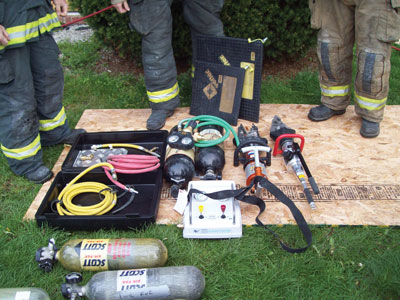 |
|
| Photo 1: Airbags and hydraulic tools are among an assortment of equipment that is needed for heavy lifting on the fire ground. Photos by Mark van der Feyst |
|
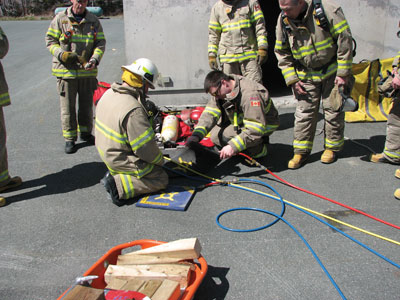 |
|
| Photo 2: All equipment should be brought to the staging area, checked that it is in proper working order and then left connected for rapid deployment. |
|
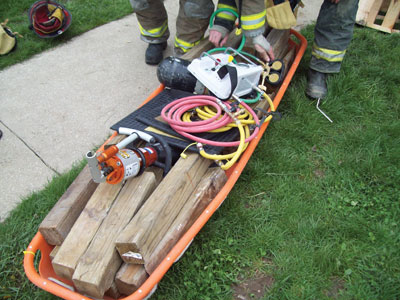 |
|
| Photo 3: Two to four firefighters can bring all the necessary equipment from the truck to the fire ground at once by filling the stokes basket. | |
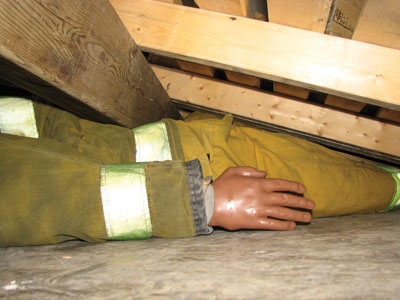 |
|
| Photo 4: Just a small amount of clearance – one to two inches – is needed to free the downed firefighter.Photo 3: Two to four firefighters can bring all the necessary equipment from the truck to the fire ground at once by filling the stokes basket. |
|
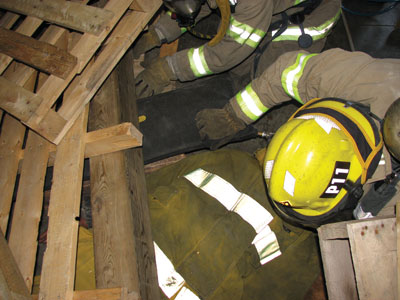 |
|
| Photo 5: To ensure stabilization, cribbing must continue as the airbags are lifting the load. |
|
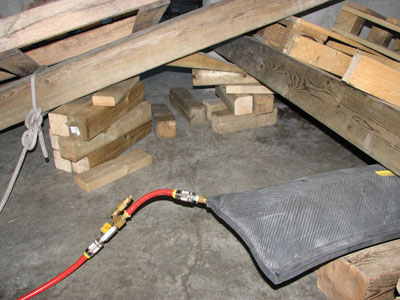 |
|
| Photo 6: A cantilever lift, which uses just one airbag, is effective but dangerous; two airbags and continuous cribbing is the best option for heavy lifting. |
|
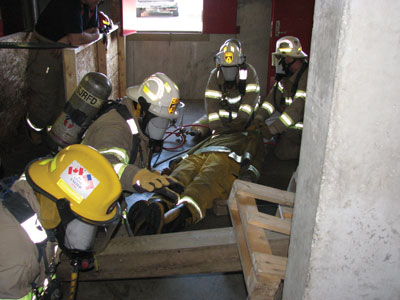 |
|
| Photo 7: Once the load has been lifted, one to two firefighters can remove the downed firefighter, while a third RIT member oversees the entire operation and guides the removal. |
Time is against a firefighter on the fire ground. At the scene of a structural fire, having the right equipment staged and ready to go is crucial; leaving the equipment on the apparatus will delay any type of response. Airbags and hydraulic tools are among the equipment that will be needed for any type of heavy lifting (see photo 1). This equipment needs to be checked to make sure it is in proper working order and then left connected for rapid deployment (see photo 2). It’s a good idea to fill the stokes basket with the equipment and cribbing (see photo 3) so that two to four firefighters can bring in all the equipment at once.
When a firefighter is trapped under heavy debris or objects, rescuers need to lift the objects only about an inch or two so that the firefighter can be dragged out and away. The small clearance will be enough to free the firefighter of any obstructions and remove him or her to a safer location (see photo 4). This lift can be accomplished using high-pressure air bags, which are generally used for auto-extrication. Just one or two airbags are needed to accomplish the lift. Except in extreme circumstances, avoid double-stacking the airbags, which is a common practice in auto-extrication; double-stacking will require another set of airbags and the cylinders to operate them. It is better to use more cribbing than to double-stack the airbags.
Because the load on top of the firefighter is unstable, cribbing must be used to help stabilize the load. In case of secondary collapse, a stabilized load will provide a protective space around the downed firefighter.
Stabilizing the load also involves balancing the load. A collapse pile is very unbalanced as pieces of debris and objects are resting very precariously on each other. Any shifting of one object or part of the pile may lead to other objects moving and creating a secondary collapse. Cribbing the load around the firefighter also helps to balance the load to prevent unintentional shifting.
Once RIT members locate the downed firefighter and determine that the firefighter is pinned by collapsed debris, they need to start to sizing up the best spots for the airbags. When the airbags are in position (see photo 5) and the load has been stabilized, the lift can then commence. Cribbing must continue when rescuers are doing the lift – remember to crib as you go. With proper cribbing in place, the load will not fall back down onto the firefighter if it shifts.
In photo 6, one airbag is used to temporarily raise the load so that RIT members can remove the firefighter (see photo 4). One airbag can be used to accomplish a lift but the process needs to be conducted very carefully.
This type of lift – where the load is being pivoted on one end – is called a cantilever lift. A cantilever lift can be very dangerous as it can shift very easily. Using two airbags on either side of the firefighter is a better option as the lift happens simultaneously on both sides with the weight of the load on the airbags.
Hydraulic tools such as the spreaders can be used to lift instead of airbags. The tools are quicker to deploy and operate but come with some risk: the load can slip off of the spreader tip very easily and quickly. If you search the web for a video showing the NYPD using the spreaders to lift a car off of a pedestrian, you will see how quickly and easily the load can slip and fall back down onto the person. The crib-as-you-go principle needs to be applied.
Once the load has been lifted one to two inches above the downed firefighter, the firefighter can be pulled out and freed. As shown in photo 7, it will take one or two RIT firefighters to effectively remove the downed firefighter. Careful attention needs to be paid here, as pulling too hard and too quickly may create more problems. If the firefighter is caught on any debris, the removal process may shift the load or knock some of the cribbing loose and create an unstable load. One firefighter needs to be in charge of the operation and guide the removal of the downed firefighter, which involves good communication among all RIT members and a controlled pace of work to be effective.
Mark van der Feyst is a 13-year veteran of the fire service. He works for the City of Woodstock Fire Department in Ontario. Mark instructs in Canada, the United Stats and India and is a local-level suppression instructor for the Pennsylvania State Fire Academy and an instructor for the Justice Institute of B.C. E-mail mark at Mark@FireStarTraining.com.
Print this page